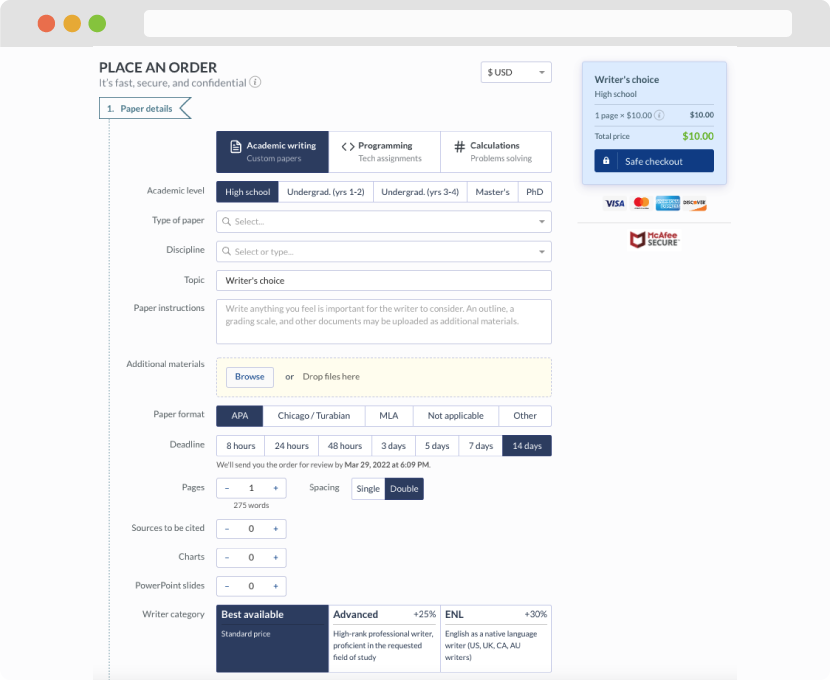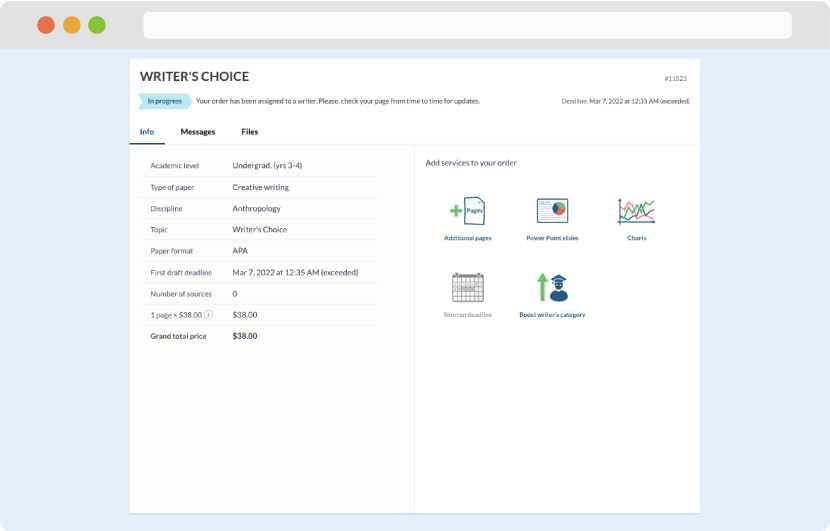These estimates include the influence of other extraneous variables, such as confounders. Confounding is often considered a type of bias, but it is a real relationship that requires an adjustment in the study design or analysis. Understanding how to identify confounding is important as most associations have multiple causal factors. Recognizing if a study adjusted for the appropriate confounding variables is important to determine the validity of the association. To assist your proficiency with the concept of confounding, and how it ultimately affects public health, this practice assignment has been provided.
Complete Problems 1 to 4 from the “Multicausality: Confounding – Assignment” by Schoenbach, located in your Topic Materials. Check your answers against the solutions presented in the “Multicausality: Confounding – Assignment Solutions” Topic Material.
While APA style is not required for the body of this assignment, solid academic writing is expected, and documentation of sources should be presented using APA formatting guidelines, which can be found in the APA Style Guide, located in the Student Success Center.
You are not required to submit this assignment to LopesWrite.
_____________________________________________________________________________________________
www.epidemiolog.net © Victor J. Schoenbach Multicausality: Confounding – Assignment – 373
rev. 6/9/96, 9/6/1999, 3/30/2001
Multicausality: Confounding – Assignment
1. Some years ago several studies were published showing an association between reserpine (a drug
used to lower blood pressure) and breast cancer in women. Since obesity is associated both with
breast cancer and with hypertension (elevated blood pressure), the suspicion arose that the
association between reserpine and breast cancer could be secondary to the effect of obesity.
Assume that a cohort study had been conducted to address this question and produced the
following data:
Annual age-adjusted incidence of breast cancer per 100,000 women
by body weight and reserpine status
Reserpine use
Yes No Total
Obese 12.50 8.30 8.72
Not Obese 6.40 4.10 4.22
Total 10.47 6.14
Answer the following questions on the basis of the above data (ignore considerations of
statistical significance and precision). For each answer cite the most relevant figures from the
table, allowing for the possibility that one factor affects the observed relation between the other
factor and breast cancer risk.
a. Is reserpine a risk factor for breast cancer?
b. Is obesity a risk factor for breast cancer?
c. Is reserpine use associated with obesity?
d. Is the association between reserpine and breast cancer attributable to obesity?
_____________________________________________________________________________________________
www.epidemiolog.net © Victor J. Schoenbach Multicausality: Confounding – Assignment – 374
rev. 6/9/96, 9/6/1999, 3/30/2001
2. A 20-year retrospective cohort study of the incidence of chronic obstructive pulmonary disease
(COPD) was performed in two occupational cohorts with different levels of S02, copper smelters
(high SO2) and truck maintenance workers (low SO2). In 1961, when the cohort was defined,
55% of the smelter workers and 55% of the truck shop workers were smokers. The relative risk
for COPD due to smoking was 10.5 among the smelters and 3.0 among the truck shop workers.
Pulmonary function data taken in 1980 showed that 75% of the smelter workers had low FEV1
values (<90% predicted) and 33% of the truck shop workers had low FEV1 values. COPD and
low FEV1 were strongly associated in each cohort. [FEV1 is forced expiratory volume in one
second.]
a. In the above study, is smoking a likely confounder of the association between COPD and
SO2 exposure (i.e., in smelters vs. truck shop workers)? Briefly discuss (1-3 sentences).
b. The best reason for not controlling for low FEV1 as a potential confounder is:
A. Low FEV1 is not associated with SO2 exposure according to the data.
B. Low FEV1 is not associated with COPD according to the data.
C. Low FEV1 is not an independent risk factor for COPD.
D. Low FEV1 is not associated with smoking according to the data.
3. Diagrammed below are two possible causal models involving oral contraceptive use (OC), plasma
homocysteine level (HCS) and myocardial infarction (MI). Briefly discuss the implications of the
two models with respect to whether HCS would need to be considered as a potential confounder
of the relationship between OC and MI.
OC
OC
HCS MI HCS MI
Other
factors
Other
factors
[arrows show hypothesized causal pathways]
_____________________________________________________________________________________________
www.epidemiolog.net © Victor J. Schoenbach Multicausality: Confounding – Assignment – 375
rev. 6/9/96, 9/6/1999, 3/30/2001
4. The following table, published in the Oxford Family Planning Association Contraceptive Study
(Vessey et al.), shows characteristics of individuals at the time of recruitment in to the study.
Based on the data presented in the table, discuss three potential sources of bias apparent from
the characteristics of the three contraceptive groups. How would these factors be expected to
influence the appearance of a causal association between oral contraceptive use and circulatory
deaths if no adjustment for the factors were carried out?
Some characteristics of subjects in the three contraceptive
groups at time of recruitment
Method of Contraception
in use on Admission
Characteristic Oral Diaphragm IUD
Percentage aged 25-29 years 56 35 35
Percentage in Social Classes I or II* 39 49 34
Percentage smoking 15 or more cig./day 17 7 12
Mean Quetelet’s Index** 2.25 2.26 2.31
Percentage*** with history of:
Hypertension 0.91 0.67 0.50
Pre-eclamptic toxaemia 12.58 16.26 16.07
Stroke 0.03 0.04 0.30
Rheumatic fever 0.76 0.66 1.04
Rheumatic heart disease 0.09 0.26 0.32
Congenital heart disease 0.12 0.31 0.16
Venous thromboembolism 0.87 4.30 7.96
* Registrar General’s classification [Social Class I is highest]
** Weight (g) / height (cm)2.
*** Standardized by indirect method for age and parity. See Vessey, et al.
5. The following questions (from the 1985 EPID 168 second midterm exam) are based on data
from Kantor AF, Hartge P, Hoover RN, et al. Urinary tract infection and risk of bladder cancer.
Am J Epidemiol 1984;119:510-5). In that study, 2982 newly-diagnosed bladder carcinoma patients
identified through the U.S. National Cancer Institute SEER (Surveillance, Epidemiology and End
Results) Program during a one-year period beginning in December 1977 were interviewed. 5782
population controls from the same geographic areas covered by SEER were selected using an
age- and sex-stratified random sample of the general populations, with 2:1 frequency-matching of
controls to cases. Information on physician-diagnosed urinary tract infections (UTI) more than
one year before interview (and many other factors) was obtained through personal interviews
using structured questionnaires in respondents’ homes. The following data are from Table 1 in
Kantor, Hartge, Hoover et al.:
_____________________________________________________________________________________________
www.epidemiolog.net © Victor J. Schoenbach Multicausality: Confounding – Assignment – 376
rev. 6/9/96, 9/6/1999, 3/30/2001
Table 1
Relative risks (RR) of bladder cancer associated with
history of urinary tract infection,*
by number of infections;
10 geographic areas of the United States, 1978
Males Females
No. of
urinary tract
infections
Cases Controls RR
95%
confidence
interval
Cases Controls RR
95%
confidence
interval
0 1758 3642 1.0+ 398 979 1.0+
1 or 2 309 423 1.5 (1.3-1.8) 176 296 1.2 (0.9-1.5)
3+ 146 152 2.0 (1.6-2.6) 145 206 2.1 (1.6-2.7)
* Maximum likelihood estimate of relative risk adjusted for race, age, smoking status (never
smoked, ex-smoker, current smoker) from stratified analyses.
+ Reference category
a. The sex-specific relative risks for bladder cancer (BC) shown in Table 1 are adjusted for race,
age, and smoking status. Which one of the following could be the relative risk of BC risk for
3+ urinary tract infections (UTI) adjusted for race, age, smoking status, and gender?
[Choose one best answer]
A. 1.33
B. 1.92
C. 2.05
D. None of the above.
b. Using the data in Table 1, construct a labeled 2 by 2 table for estimating the crude (with
respect to race, age, smoking status, and gender) relative risk for BC in men and women who
have a history of 3+ UTI compared to men and women with no history of UTI. Your
answer should show the correct formula and substitution.
c. Is gender associated with history of 3+ UTI? Support your answer with the most relevant
numbers from Table 1.
d. Is gender a confounder of the association between BC risk and history of 3+ UTI? Support
your answer with data from Table 1 and/or your answers to the two preceding questions._
Essay Writing Service Features
Our Experience
No matter how complex your assignment is, we can find the right professional for your specific task. Achiever Papers is an essay writing company that hires only the smartest minds to help you with your projects. Our expertise allows us to provide students with high-quality academic writing, editing & proofreading services.
Free Features
Free revision policy
$10Free bibliography & reference
$8Free title page
$8Free formatting
$8How Our Dissertation Writing Service Works

First, you will need to complete an order form. It's not difficult but, if anything is unclear, you may always chat with us so that we can guide you through it. On the order form, you will need to include some basic information concerning your order: subject, topic, number of pages, etc. We also encourage our clients to upload any relevant information or sources that will help.
Complete the order form
Once we have all the information and instructions that we need, we select the most suitable writer for your assignment. While everything seems to be clear, the writer, who has complete knowledge of the subject, may need clarification from you. It is at that point that you would receive a call or email from us.
Writer’s assignment
As soon as the writer has finished, it will be delivered both to the website and to your email address so that you will not miss it. If your deadline is close at hand, we will place a call to you to make sure that you receive the paper on time.
Completing the order and download